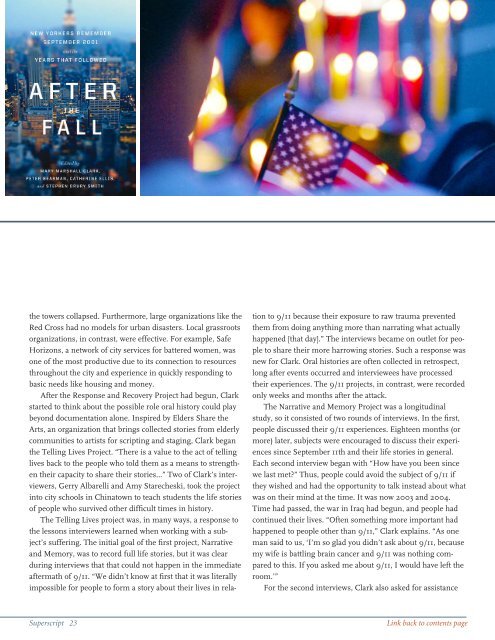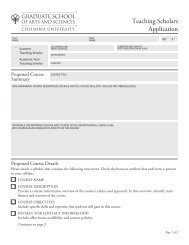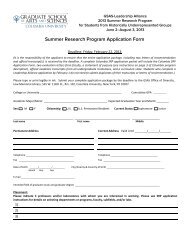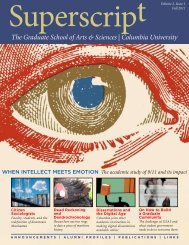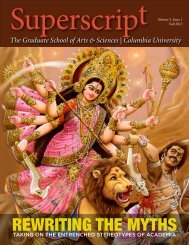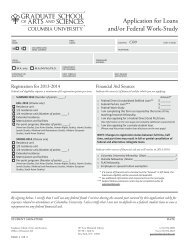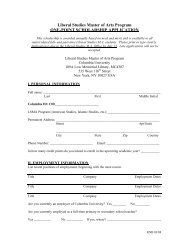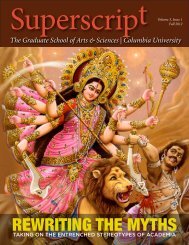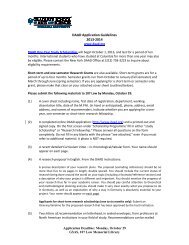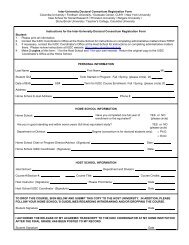PDF for Printing - Graduate School of Arts and Sciences - Columbia ...
PDF for Printing - Graduate School of Arts and Sciences - Columbia ...
PDF for Printing - Graduate School of Arts and Sciences - Columbia ...
- No tags were found...
You also want an ePaper? Increase the reach of your titles
YUMPU automatically turns print PDFs into web optimized ePapers that Google loves.
the towers collapsed. Furthermore, large organizations like theRed Cross had no models <strong>for</strong> urban disasters. Local grassrootsorganizations, in contrast, were effective. For example, SafeHorizons, a network <strong>of</strong> city services <strong>for</strong> battered women, wasone <strong>of</strong> the most productive due to its connection to resourcesthroughout the city <strong>and</strong> experience in quickly responding tobasic needs like housing <strong>and</strong> money.After the Response <strong>and</strong> Recovery Project had begun, Clarkstarted to think about the possible role oral history could playbeyond documentation alone. Inspired by Elders Share the<strong>Arts</strong>, an organization that brings collected stories from elderlycommunities to artists <strong>for</strong> scripting <strong>and</strong> staging, Clark beganthe Telling Lives Project. “There is a value to the act <strong>of</strong> tellinglives back to the people who told them as a means to strengthentheir capacity to share their stories...” Two <strong>of</strong> Clark’s interviewers,Gerry Albarelli <strong>and</strong> Amy Starecheski, took the projectinto city schools in Chinatown to teach students the life stories<strong>of</strong> people who survived other difficult times in history.The Telling Lives project was, in many ways, a response tothe lessons interviewers learned when working with a subject’ssuffering. The initial goal <strong>of</strong> the first project, Narrative<strong>and</strong> Memory, was to record full life stories, but it was clearduring interviews that that could not happen in the immediateaftermath <strong>of</strong> 9/11. “We didn’t know at first that it was literallyimpossible <strong>for</strong> people to <strong>for</strong>m a story about their lives in relationto 9/11 because their exposure to raw trauma preventedthem from doing anything more than narrating what actuallyhappened [that day].” The interviews became on outlet <strong>for</strong> peopleto share their more harrowing stories. Such a response wasnew <strong>for</strong> Clark. Oral histories are <strong>of</strong>ten collected in retrospect,long after events occurred <strong>and</strong> interviewees have processedtheir experiences. The 9/11 projects, in contrast, were recordedonly weeks <strong>and</strong> months after the attack.The Narrative <strong>and</strong> Memory Project was a longitudinalstudy, so it consisted <strong>of</strong> two rounds <strong>of</strong> interviews. In the first,people discussed their 9/11 experiences. Eighteen months (ormore) later, subjects were encouraged to discuss their experiencessince September 11th <strong>and</strong> their life stories in general.Each second interview began with “How have you been sincewe last met?” Thus, people could avoid the subject <strong>of</strong> 9/11 ifthey wished <strong>and</strong> had the opportunity to talk instead about whatwas on their mind at the time. It was now 2003 <strong>and</strong> 2004.Time had passed, the war in Iraq had begun, <strong>and</strong> people hadcontinued their lives. “Often something more important hadhappened to people other than 9/11,” Clark explains. “As oneman said to us, ‘I’m so glad you didn’t ask about 9/11, becausemy wife is battling brain cancer <strong>and</strong> 9/11 was nothing comparedto this. If you asked me about 9/11, I would have left theroom.’”For the second interviews, Clark also asked <strong>for</strong> assistanceSuperscript 23Link back to contents page


